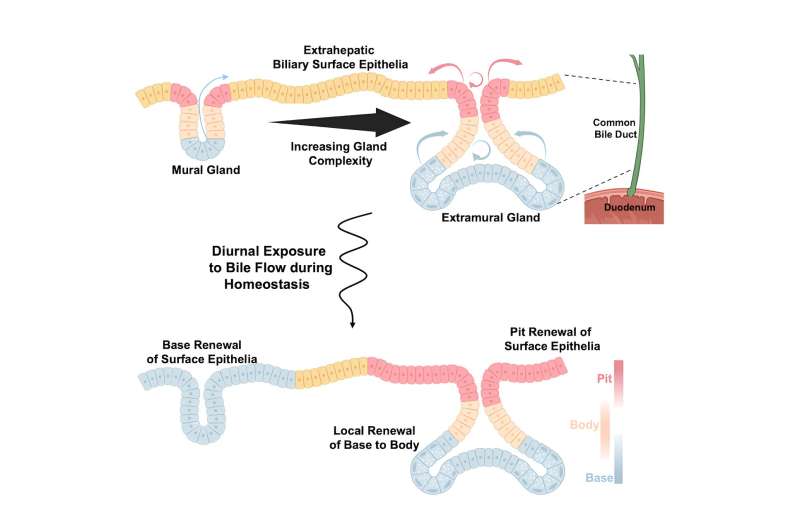This article has been reviewed according to Science X's editorial process and policies. Editors have highlighted the following attributes while ensuring the content's credibility:
fact-checked
peer-reviewed publication
trusted source
proofread
Bile duct function and disease highlighted in new study

Research from the Gupta Lab provides important insights into the extrahepatic bile ducts. These bile ducts outside of the liver are a critical but poorly understood component of the human digestive system. The study, led by Serrena Singh and supervised by Vikas Gupta, MD, Ph.D., assistant professor of medicine (digestive diseases), and published in the journal Development Cell, marks a significant step forward in understanding diseases affecting these ducts, such as primary sclerosing cholangitis and cholangiocarcinoma.
The article is titled "Heterogeneous murine peribiliary glands orchestrate compartmentalized epithelial renewal."
Gupta explains, "The extrahepatic bile ducts connect the liver to the gastrointestinal tract, carrying bile and other compounds. However, due to their small size and complex structure, these ducts have been a challenging area of study. Our research aimed to fill this knowledge gap, focusing on the epithelial lining within these ducts."
The team employed innovative methods to study the complex structure of the extrahepatic bile duct. "We used whole organ three-dimensional imaging and genetic labeling to track cells within different compartments of the extrahepatic bile duct. This helped us understand how these glands maintain homeostasis," said Gupta.
One key finding was the discovery of two separate zones within the duct, each independently responsible for renewing different parts of the duct. This compartmentalization mirrors what is seen in other organs like the body of the stomach, suggesting broader implications for understanding human biology.
Gupta highlighted the clinical relevance of these findings. "We've known that the peribiliary glands become very active during diseases like cholangiocarcinoma. Studying how different compartments of epithelial cells change during biliary neoplasia can potentially give us better insight into cholangiocarcinoma."
Despite these advances, Gupta cautioned about the limitations of their research. "Our study was conducted in a preclinical model, and while this provides valuable insights, it may not fully represent human biology. The difficulty in accessing whole human extrahepatic bile duct tissue for research is a significant hurdle."
Looking forward, the team plans to delve deeper into the cellular origins of cancer development. "By understanding which cells within these compartments might initiate cancer, we hope to uncover new avenues for early detection and treatment," Gupta said.
This research stands out for its potential to transform our understanding of a traditionally understudied area of human anatomy and disease. "Our findings open the door to further exploration into how these ducts function and how diseases affecting them develop. This could lead to better diagnostic tools and treatments for conditions that currently have limited therapeutic options," Gupta said.
More information: Serrena Singh et al, Heterogeneous murine peribiliary glands orchestrate compartmentalized epithelial renewal, Developmental Cell (2023). DOI: 10.1016/j.devcel.2023.10.004





















